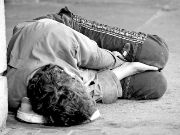Thank you to Ark of Hope for Children for their work in investigating the child abuse/human trafficking connection and the courage they portray in publishing their findings. The child abuse/human trafficking connection is hard to ignore.
 Re-posted from Ark of Hope for Children
Re-posted from Ark of Hope for ChildrenFor the entire article, click here.
Runaways:
Many youth, especially U.S. citizen children trafficked within the U.S., run away from problems at home and may be exploited as a result of emotional vulnerability, homelessness and the need to survive. Youth who run away from home and engage in "survival sex" often find themselves vulnerable to pimps and traffickers involved in prostitution networks.
Approximately 55% of street girls, and a good percentage of boys, engage in formal prostitution and some think it is much higher than that.
This means that a child client who has been homeless or living on the street for any amount of time has a great likelihood of having been sexually exploited or trafficked.
The sexual exploitation of children is not limited to particular racial, ethnic or socioeconomic groups, although children from poor families appear to be at somewhat higher risk of commercial sexual exploitation. In fact, most of the street children encountered in the study were Caucasian youths who had run away from middle-class families. One clear theme is the is proportionate number of street youth who have histories of recurrent physical or sexual abuse at home and took to the streets in a desperate effort to bring their abuse to an end.
According to these researchers, child sexual exploitation in the United States affects as many boys as girls, but boys are less well-served by social service and law enforcement systems because of the widespread belief that boys are better able than girls to fend for themselves. Without intervention, research has shown many boys shift from being victims of sexual abuse to victimizing other boys and girls as pimps and traffickers.
People are recruited in several different ways such as through fake employment agencies, acquaintances, newspaper ads, front businesses, word of mouth or abduction. Traffickers may be neighbors, friends, returnees, agricultural operators, owners of small businesses, diplomats and even families. Increasingly, however, the traffickers are organized crime syndicates, often in collaboration with corrupt law enforcement entities, government officials or employers, who may use several intermediaries from the first point of contact to the final destination of the victim. If the victim is transported, they use both legal and illegal means of transport and various techniques to keep their victim enslaved.
They may keep them under lock and key or in isolation from the public and from their family members or support networks, confiscate their passports or identification documents, use the threat of violence against the enslaved person or their families, threaten them with shame, fear of imprisonment or deportation, and control their money.
The psychological effects of torture are helplessness, shame and humiliation, shock, denial and disbelief, disorientation and confusion, and anxiety disorders including post traumatic stress disorder, phobias, panic attacks and depression. Victims may experience Traumatic Bonding (Stockholm Syndrome) – a form of coercive control in which the perpetrator instills in the victim fear as well as gratitude for being allowed to live or for any other perceived favors, however small.
Click to read about Ark of Hope's planned Harbourage Safe Homes for Child Trafficking Victims

No comments:
Post a Comment